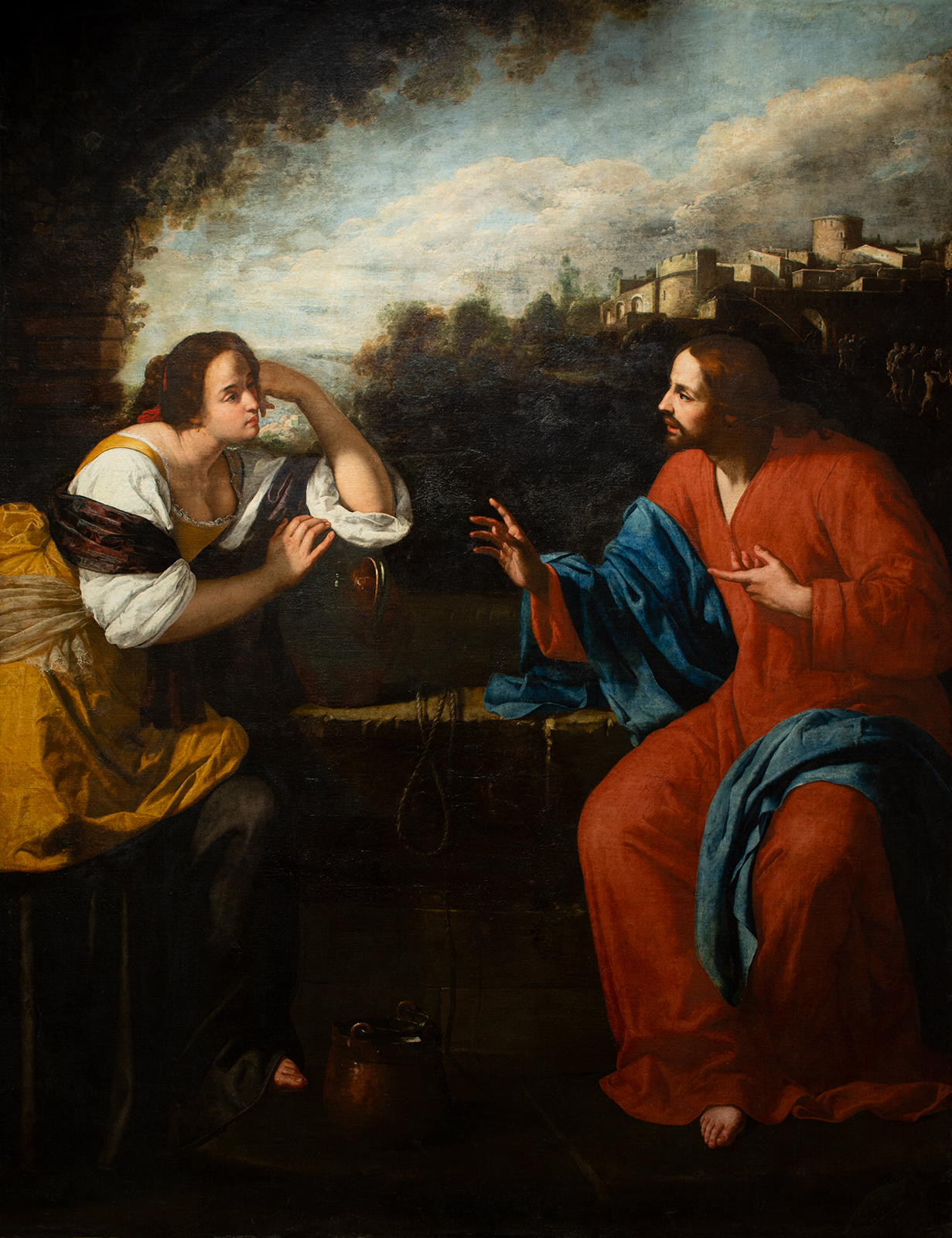Born in Rome and trained in her father Orazio Gentileschi’s studio, Artemisia was strongly influenced by Caravaggio and the Baroque movement. She is known for her realistic, dramatic and often violent subject matter, as well as her preference for female and religious representations such as Mary Magdalene, Judith, Esther, etc.
In this painting, the artist depicts an episode from the Gospel according to John: at noon, Jesus, thirsty and tired by his journey through Samaria, was sitting by Jacob’s well, near the city of Sychar. He engages in a conversation with a Samaritan woman who had come to draw water from the well, offering to her “living water” that has the power to quenche anyone who drinks it.
Christ and the Samaritan are represented sitting at the well in full conversation, with the woman apparently paying particular attention to the words spoken by Jesus. Trees and architecture frame the scene, while a sky filled with heavy clouds encompasses a city in the distance, from which a group of men – probably the disciples – make their exit. This is one of the few works by Artemisia Gentileschi with a complete landscape.
The elements usually depicted in this scene are present: the well, the pitcher, the rope. The vivid colors of the characters’ clothing as well as the detailed background have been associated with the works the artist produced during her stay in Naples. Furthermore, in a letter written from Naples on 24th November 1637, addressed to her patron, the papal secretary Cassiano dal Pozzo, Artemisia describes a painting of hers depicting “the Woman of Samaria with Christ and the twelve apostles in a distant landscape.”
A non-invasive scientific investigation campaign, conducted by RES, has allowed for a more in-depth analysis of the technical execution of this work.
In the case of this painting, infrared reflectography has not revealed the presence of a preparatory drawing of a carbonaceous nature made prior to the painting phase. However, the presence of such drawing cannot be definitively excluded as it could, in fact, have been made with chalk, sanguine, or another infrared “transparent” techniques.
Infrared imagery has, on the other hand, allowed for the identification of some modifications and adjustments to the composition made by the artist during the painted phase.
The reading of the image suggests that:
- the artist slightly repositioned Christ’s left hand as well as the Samaritan’s left arm;
- the draperies of Christ’s cloak underwent some minor changes;
- In the foliage of the tree at the top left, a ring can be seen hanging. In direct light, the ring is visible but difficult to distinguish;
- Finally, the visage of the Samaritan undergoes several changes: initially, her face appeared more profiled and stood higher; her eyes had a different position, suggesting a less angled head. There is a pentimento in her forehead: her hair originally fell more in front of her face.
Some parts of the painting appear more transparent; this is due to an alteration related to the aging of oil paint. This transparency allows for, in some cases, the observation of the chronological order in which the artist executed some elements of the painting.
The architectural contours, especially of the well, are visible in transparency as seen in Christ’s right sleeve: in all likelihood, Christ’s cloak was painted after the well was placed.
This alteration is also present on the left side of the painting, especially visible on the low stone and brick wall: a tree was placed by the artist after drawing and painting the wall. The bricks are particularly visible in transparency under direct light and on infrared reflectography.
The analysis of infrared reflectography has also led to another hypothesis: on the well, between Christ and the Samaritan, in the right sleeve of Christ, as well as in the tree’s foliage, large tears seem to be visible across the canvas. The first could be an old stitch, probably reworked by the artist herself.
The gaps in the paint layer are visible under infrared, with the stitching thread appearing white. The gaps would have been repainted (cracks are visible under raking light) and extensively revarnished (visible under ultraviolet light).
On the ultraviolet light image, a fairly recent retouching campaign (darker blue spots), is visible along the edges of the painting, on the well, on the left wall, as well as on the figures.
The examination of the false colour infrared suggests the use of the following pigments: vermilion for the cloak of Christ and the ribbon in the hair of the Samaritan woman; the blue drapery of Jesus appears to correspond to azurite, while a Naples yellow or orpiment was probably used for the dress of the Samaritan.
Artemisia Gentileschi, Christ and the Samaritan Woman at the Well, 1637, oil on canvas, Palazzo Blu – Pisa.













